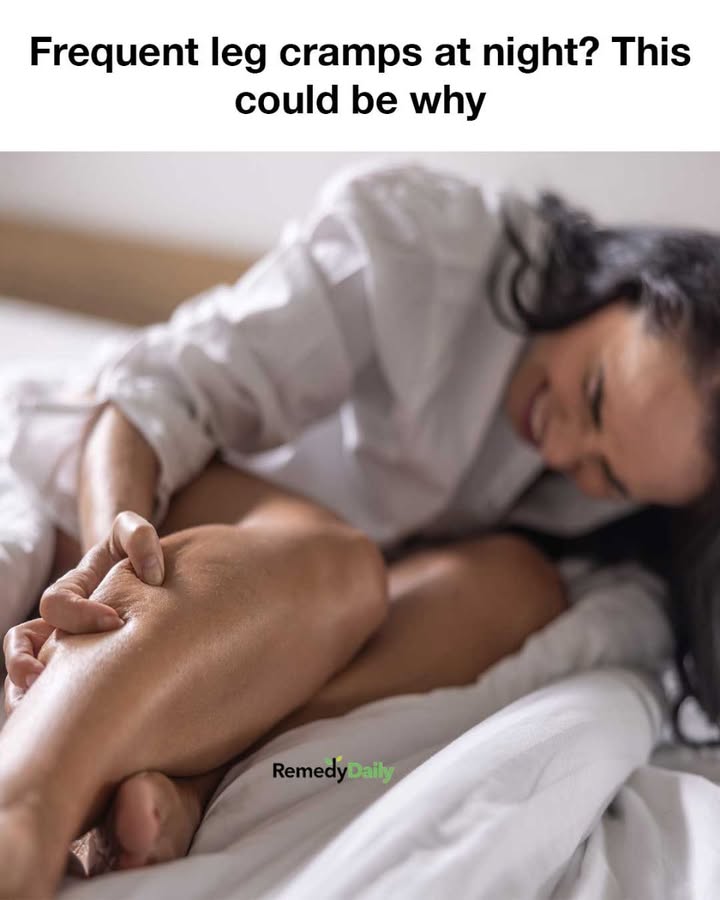Many people experience the discomfort of leg cramps at night, a condition that can disrupt sleep and lead to fatigue. These cramps, often referred to as nocturnal leg cramps, are sudden, involuntary contractions of the muscles in the leg. They can last from a few seconds to several minutes and can be quite painful, leaving the muscle sore for hours afterward.
While occasional leg cramps are common and usually harmless, frequent occurrences can be a sign of an underlying issue. Understanding the potential causes of these cramps can help in managing them effectively and improving overall quality of life. This article explores some of the most common reasons behind frequent leg cramps at night and offers insights into how they can be addressed.
1. Understanding Nocturnal Leg Cramps
Nocturnal leg cramps are characterized by sudden, intense pain in the leg muscles, typically affecting the calf, though they can also occur in the thighs or feet. These cramps are more common in older adults, with studies suggesting that up to 60% of adults experience them at some point. The exact cause of nocturnal leg cramps is not well understood, but they are thought to be related to muscle fatigue and nerve dysfunction.
Unlike restless leg syndrome, which is a neurological disorder causing an uncontrollable urge to move the legs, nocturnal leg cramps involve actual muscle contractions. They can occur spontaneously or be triggered by prolonged sitting, dehydration, or overexertion. Understanding the difference between these conditions is crucial for proper management and treatment.
2. Dehydration: A Common Culprit
Dehydration is a well-known trigger for muscle cramps, including those that occur at night. When the body is dehydrated, it lacks the necessary fluids to maintain proper muscle function. This can lead to an imbalance of electrolytes, which are essential for muscle contraction and relaxation.
To prevent dehydration-related cramps, it’s important to consume adequate amounts of water throughout the day. The general recommendation is to drink at least 8 cups (64 ounces) of water daily, though individual needs may vary based on activity level and climate. Monitoring urine color can be a simple way to gauge hydration levels; pale yellow indicates proper hydration, while darker urine suggests the need for more fluids.
3. Electrolyte Imbalance: The Role of Potassium and Magnesium
Electrolytes such as potassium and magnesium play a critical role in muscle function. Potassium helps transmit nerve signals to muscles, while magnesium is involved in muscle relaxation. An imbalance in these electrolytes can lead to muscle cramps.
Low potassium levels, known as hypokalemia, can result from inadequate dietary intake or excessive loss through sweat or urine. Foods rich in potassium, such as bananas, oranges, and spinach, can help maintain proper levels. Similarly, magnesium deficiency can be addressed by consuming nuts, seeds, and whole grains. In some cases, supplements may be necessary, but they should be taken under medical supervision to avoid adverse effects.
4. Sedentary Lifestyle and Its Impact
A sedentary lifestyle can contribute to the development of nocturnal leg cramps. Prolonged periods of inactivity can lead to muscle weakness and poor circulation, both of which can trigger cramps. Regular physical activity helps keep muscles strong and flexible, reducing the likelihood of cramping.
Incorporating stretching exercises into daily routines can also be beneficial. Stretching the calf muscles before bed, for example, can help prevent nighttime cramps. Activities like walking, cycling, or swimming can improve overall muscle tone and circulation, further reducing the risk of cramps.
5. Overexertion: When Exercise Backfires
While regular exercise is beneficial, overexertion can lead to muscle fatigue and cramps. Intense physical activity, especially if the body is not accustomed to it, can strain the muscles and lead to cramping.
It’s important to gradually increase the intensity and duration of exercise to allow the body to adapt. Ensuring proper warm-up and cool-down routines, as well as staying hydrated and maintaining adequate electrolyte levels, can help prevent exercise-induced cramps. Listening to the body’s signals and allowing for adequate rest and recovery is also crucial.
6. Poor Circulation and Its Effects
Many people experience the discomfort of leg cramps at night, a condition that can disrupt sleep and lead to fatigue. These cramps, often referred to as nocturnal leg cramps, are sudden, involuntary contractions of the muscles in the leg. They can last from a few seconds to several minutes and can be quite painful, leaving the muscle sore for hours afterward.
While occasional leg cramps are common and usually harmless, frequent occurrences can be a sign of an underlying issue. Understanding the potential causes of these cramps can help in managing them effectively and improving overall quality of life. This article explores some of the most common reasons behind frequent leg cramps at night and offers insights into how they can be addressed.
1. Understanding Nocturnal Leg Cramps
Nocturnal leg cramps are characterized by sudden, intense pain in the leg muscles, typically affecting the calf, though they can also occur in the thighs or feet. These cramps are more common in older adults, with studies suggesting that up to 60% of adults experience them at some point. The exact cause of nocturnal leg cramps is not well understood, but they are thought to be related to muscle fatigue and nerve dysfunction.
Unlike restless leg syndrome, which is a neurological disorder causing an uncontrollable urge to move the legs, nocturnal leg cramps involve actual muscle contractions. They can occur spontaneously or be triggered by prolonged sitting, dehydration, or overexertion. Understanding the difference between these conditions is crucial for proper management and treatment.
2. Dehydration: A Common Culprit
Dehydration is a well-known trigger for muscle cramps, including those that occur at night. When the body is dehydrated, it lacks the necessary fluids to maintain proper muscle function. This can lead to an imbalance of electrolytes, which are essential for muscle contraction and relaxation.
To prevent dehydration-related cramps, it’s important to consume adequate amounts of water throughout the day. The general recommendation is to drink at least 8 cups (64 ounces) of water daily, though individual needs may vary based on activity level and climate. Monitoring urine color can be a simple way to gauge hydration levels; pale yellow indicates proper hydration, while darker urine suggests the need for more fluids.
3. Electrolyte Imbalance: The Role of Potassium and Magnesium
Electrolytes such as potassium and magnesium play a critical role in muscle function. Potassium helps transmit nerve signals to muscles, while magnesium is involved in muscle relaxation. An imbalance in these electrolytes can lead to muscle cramps.
Low potassium levels, known as hypokalemia, can result from inadequate dietary intake or excessive loss through sweat or urine. Foods rich in potassium, such as bananas, oranges, and spinach, can help maintain proper levels. Similarly, magnesium deficiency can be addressed by consuming nuts, seeds, and whole grains. In some cases, supplements may be necessary, but they should be taken under medical supervision to avoid adverse effects.
4. Sedentary Lifestyle and Its Impact
A sedentary lifestyle can contribute to the development of nocturnal leg cramps. Prolonged periods of inactivity can lead to muscle weakness and poor circulation, both of which can trigger cramps. Regular physical activity helps keep muscles strong and flexible, reducing the likelihood of cramping.
Incorporating stretching exercises into daily routines can also be beneficial. Stretching the calf muscles before bed, for example, can help prevent nighttime cramps. Activities like walking, cycling, or swimming can improve overall muscle tone and circulation, further reducing the risk of cramps.
5. Overexertion: When Exercise Backfires
While regular exercise is beneficial, overexertion can lead to muscle fatigue and cramps. Intense physical activity, especially if the body is not accustomed to it, can strain the muscles and lead to cramping.
It’s important to gradually increase the intensity and duration of exercise to allow the body to adapt. Ensuring proper warm-up and cool-down routines, as well as staying hydrated and maintaining adequate electrolyte levels, can help prevent exercise-induced cramps. Listening to the body’s signals and allowing for adequate rest and recovery is also crucial.
6. Poor Circulation and Its Effects

